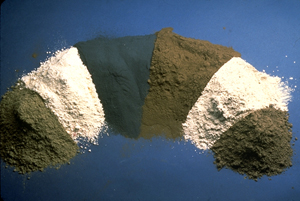You have learned that water strongly affects the color of a concrete countertop mix, as does precision of measuring and measuring by weight, not volume. This final article in the color consistency series lists several other reasons you might encounter inconsistency in your concrete countertop mixes.
- Variability in the ingredients themselves
From year to year, the ingredients you use can vary, even if you buy the same ingredient from the same manufacturer. Pigments tend to be very consistent, but cements, especially gray cements, are not. Your colors that have less pigment, and therefore obtain most of their color from the cement, will exhibit more variability thann heavily pigmented colors.
- Use of pozzolans
You may use pozzolans such as metakaolin, VCAS, fly ash, slag or silica fume in your mixes. Some of these pozzolans, especially waste products such as slag, can be highly variable in color. And, pozzolans such as silica fume can impart a very distinct color to the concrete. Besides the fact that different pozzolans have different actions and properties, you should not vary which pozzolans you use in your mix designs if you want to achieve color consistency.
Various pozzolans. Photo courtesy www.cement.org
- Use of admixtures such as superplasticizer
Admixtures like superplasticizers can influence color, not because they add color, but because they can act like dispersants, aiding in cement and pigment dispersion and the resulting color strength. Other admixtures usually have little effect on the color, like fibers, accelerators or retarders, however calcium chloride accelerators are an exception and should be avoided for this and other reasons.
- Not blending ingredients thoroughly
Thorough and complete blending of all of the concrete ingredients is very important to achieving a uniform and consistent color. All of the pigment added to the mixer should be uniformly blended. If pigment is stuck to the sides of the mixer or in lumps or streaks then the resulting concrete will not be consistent with other batches nor will the color of that batch be uniform.
- Adding liquid pigment to the mix water
Adding liquid pigment to the mix water before adding the now pigmented mix water to the concrete can cause color inconsistency because a significant amount of the pigment usually remains in the bucket.
Liquid pigments are really ultra fine pigment particles suspended in a liquid. If the liquid pigment is added to mix water, the pigment particles will quickly settle out because the suspension fluid is now greatly diluted by the mix water. No amount of stirring will suspend all of the pigment particles, so much of the color remains in the bucket rather than going into the mixer.
When done carefully, it is possible to add the liquid pigment to a portion of the mix water and then use the remaining mix water to rinse out any pigment residue. But this involves extra work and requires extra attention. A simpler process would be to add the liquid pigment directly to the mixer and then to rinse out the pigment container with the mix water as it is added.
- Inconsistent curing practices
Curing the concrete has an effect on concrete color. Curing the concrete after casting helps “lock in” the color. If some slabs are allowed to wet cure for longer than others, the slabs that dry out sooner will appear lighter.
- Forms
Forms for fluid concrete mixes must be watertight in order to achieve consistent colors. Otherwise, color variations will show where some of the concrete leaked out of the forms. Form materials themselves (the texture and porosity) can affect the color of the concrete too.
Conclusion
Everything that goes into making concrete has some effect on its appearance. Discipline, attention to detail and knowledge of good concrete practices will make your concrete countertops as consistent as possible.

